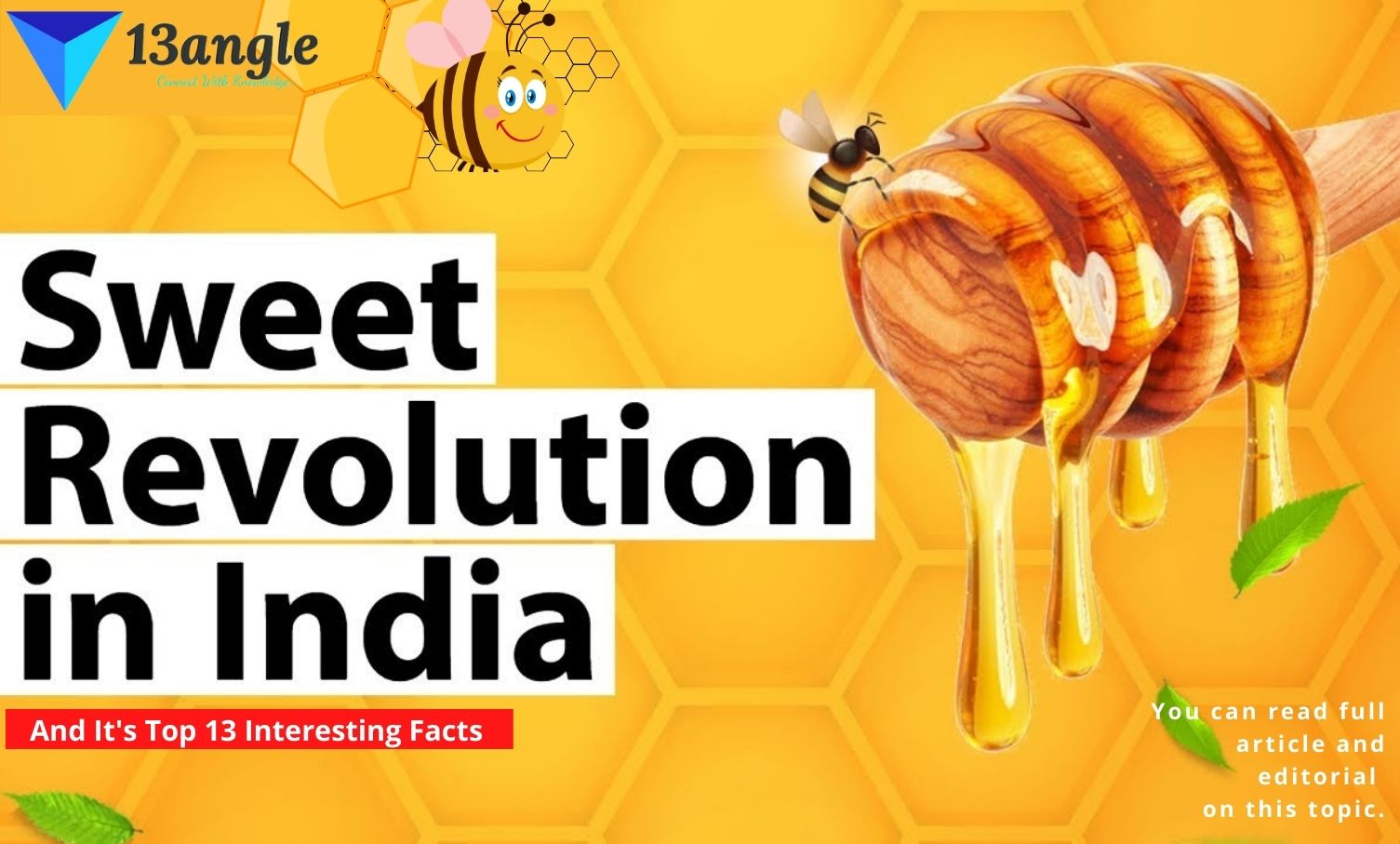- Umang Sagar
- Govt. Initiatives, Recent article
Sweet Revolution
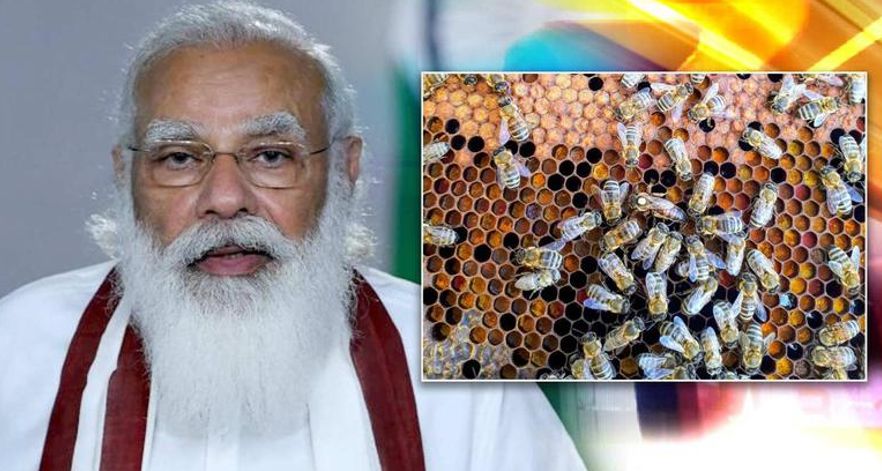
Beekeeping is a form of art that consists of maintaining honey bee provinces, usually in man-made hives, by people mostly farmers. Most such bees are honey bees in the genus API, however other honey delivering bees, for example, Melipona sting-less honey bees are also likewise kept. Beekeeping known as Apiology has been considered a scientific art throughout human history. In India, the historical record of beekeeping is actually ancient. It has been mentioned in ancient Vedas and Buddhist scriptures. After Indian independence beekeeping is being promoted through various government schemes for the rural sector with an aim to provide income and employment to the farmers and increase the production of honey and honey-related consumable products. If we talk about the current status of beekeeping, the government of India has launched a program to increase the number of farmers who are involved in beekeeping and increase their incomes simultaneously, also increasing the quality of honey delivered to the general public. This initiative is trending with the name of “SWEET REVOLUTION”.
What Is Sweet Revolution?

Honorable Prime Minister Mr. Narendra Modi has the vision that our country needs a ‘sweet revolution’ after the White Revolution, Green Revolution, Blue Revolution, ‘Sweet Revolution’ is an essential step to underline the expansion in honey production in the state, which can be a significant supporter of multiplying the pay of the farmers.
With the increase in income, the production of crops will also increase by 15%.
Sweet revolution, which is also known as “Mithi Kranti”, is a campaign of the government of India to increase apiculture in India, also known as beekeeping. This initiative came up with an aim to help farmers in increasing their incomes and accelerate the production of good quality honey and related products. Due to the increasing demands for good quality honey over the years as it is considered as nutritious naturally and other apiculture products such as royal jelly, beeswax, pollen, etc., are also in demand and used in different sectors like pharmaceuticals, food, beverages, beauty, and others. In 2016 prime minister of India Mr. Narendra Modi gave this initiative a green flag and in 2020 to provide a booster shot to the Sweet Revolution, the government launched the National Beekeeping and Honey Mission (under the Ministry of Agriculture and Farmers Welfare).
NBHM focuses on achieving the goal of ‘sweet revolution’ as a part of Atmanirbhar Bharat Abhiyaan; 11 projects of Rs. 2,560 lakh have been sanctioned under NBHM: Rs. 500 crores has been allocated for three years for the enhancement of scientific techniques of beekeeping in the country. The fundamental target of NBHM is to advance all-encompassing development of the beekeeping industry for income generation and create employment for farm and non-farm families, to improve farming/agriculture production, creating infrastructural offices, including setting up of Integrated Beekeeping Development Center (IBDC) s/ CoE, honey testing labs, honey bee illness diagnosis labs, nucleus stock, bee breeders, etc. and strengthening of women through beekeeping.
How To Start Honey Bee Farming In India?

Honey bee farming in India is not something that is discovered or found just now; collecting honey from forests has been in existence for a very long time. Honey bees produce the honey from the juice of flowers and store them in hives.
While locating the high demand for pure honey in the market can indicate that beekeeping and producing honey can be a profitable business in India at present. Not only just honey, but farmers can also make honey wax through bee farming. Any farmer can establish this agriculture-based business to gain an extra income. This is highly organic and also the government is acting really supportive in this field for the past few years. According to one date, 80% of the crop plants need to gather pollen from other plants of that same colony or species with the help of other facilities, and bees can do that same task quickly.
=> There are several things to know first if you are thinking about becoming a bee farmer in India:-
1. Beekeeping Training:-
The farmer who begins honey bee development needs specialized information and experience. Along these lines, the farmer or business visionary should work with the farmers previously doing beekeeping around there for a couple of months. You can likewise take a testament from a presumed preparing organization for this business. The business person or farmer can contact his local horticulture division or any rural college to prepare in this business to the extent practice is vital. Be that as it may, a business visionary will get this information just when he gets a useful comprehension of it in the wake of preparing from a neighborhood horticulture division or agrarian college.
2. Most Suitable Place For Bee Farming:-
You ought to choose the appropriate spot for beginning a honey field-tested strategy that ought to be dry. Undeniable degrees of dampness influence honey bees flying and honey maturing. It is important to have a characteristic or counterfeit wellspring of water at the site. Trees go about as wind belts in colder regions. The colony of bees can be set under the shade of trees, or fake game plans can be developed to give conceal. It is intended to say that assuming the business person chooses a site for a beekeeping project where trees are bountiful; he can hold the colonies of bees under the trees in the shade. Plants that give dust and honey to honey bees are called vegetation or fields. Subsequently, such a site might suit Honey Beekeeping, where many plants produce dust or honey.
3. Keep Bees Free From Pests And Diseases:-
On the off chance that the farmer or business visionary expects great benefits from his honey bee cultivating business, he ought to secure his stock and the living beings producing the products. Hence, the business person should attempt to get them far from bugs and infections. For the most part, wax moths, subterranean insects, wasps, wax scarabs, birds, windpipe vermin, parasitic bugs, Varroa destroyers, honey bee bugs, brood bugs, and so on, are normal irritations. Furthermore, to the extent the illnesses found in this cultivating are concerned, European foul-brood infection, American foulbrood, Nosema sickness, Sacbrood infection (SBV), Chalkbrood illness, Thai sacbrood infection (TSBV) and Stone brood sickness and so on accordingly, the farmer needs to make a move ahead of time for the control of explicit irritations and infections. That is, the farmer can contact the nearby agribusiness division to determine them.
The above mentioned points are just few tips to the whole run, this information was more like an overview to know what kind of business you’re stepping into. There are few more steps in the process before commencing bee farming and now lets discuss about what kind of wealth it will cost you at beginning.
First you have to purchase bee hives and the cost of one bee hive is approx Rs. 6,000 and then to keep the bees safe and generate the honey from them you have to purchase the bee boxes, one bee box’s cost is Rs. 400. After that there are so many bee equipment, wax sheets, labor charges, annual charges of feeding, etc. A sum total of Rs. 3, 40,000 is required to start bee farming in India.
Beekeeping In America
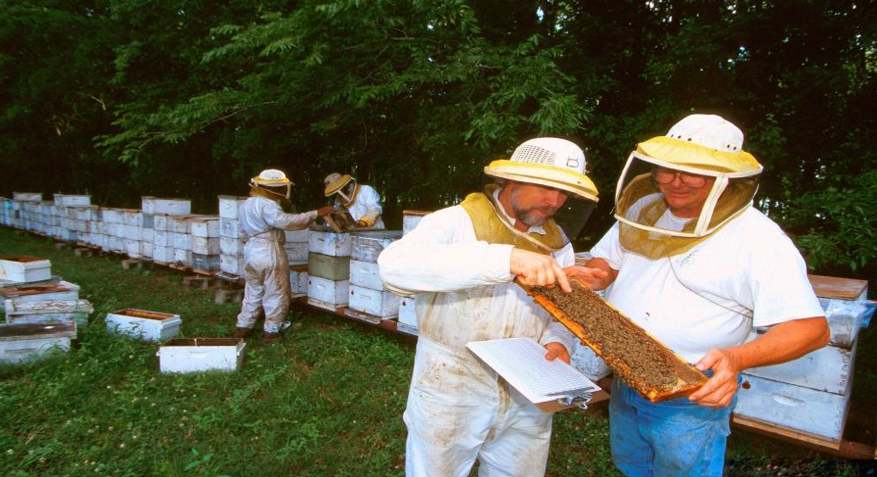
Beekeeping is a kind of art that is widely popular not only in India but also overseas. In America Beekeeping is the primary source of income for some farmers as well as for some people this is also just a hobby to do. Living in a village keeping bees in the backyard is believed to be a privilege.
Western honey bees are not local to the Americas. American pioneers imported honey bees from Europe for their honey and wax. Their worth as pollinators was valued before the end of the nineteenth century. The primary honey bee subspecies imported were probably European dim honey bees. Later Italian honey bees, Carniolan honey bees, and Caucasian honey bees were added.
Western honey bees were additionally brought from the Primorsky Krai in Russia by Ukrainian pilgrims around the 1850s. These Russian honey bees that are like the Carniolan honey bee were brought into the U.S. in 1997. The Russian honey bee has demonstrated to be more impervious to the honey bee parasites Varroa destructor and Acarapis wood, despite the fact that their business use and accessibility are very restricted in scope in light of the fact that other, better strains are accessible (e.g., VSH lines).
Before the 1980s, most U.S. leisure activity beekeepers were farmers or family members of a farmer, lived in rustic regions, and kept honey bees with procedures passed down for ages. The appearances of tracheal parasites and varroa bugs during the 1980s and little hive insects during the 1990s have made the training more challenging for the hobbyist.
=> There are three categories of beekeepers in America:
- Commercial Beekeepers – For them, beekeeping is the primary source of income.
- Sideliner – Beekeeping is the secondary source of income.
- Hobbyist – Beekeeping is just a hobby to them, it is not a significant source of income.
In America, some southern beekeepers keep bees with the main motive to raise queens and package bees for trading purposes. Northern beekeepers can purchase early-spring queens and 3-or 4-pound bundles of live working bees from the South to renew hives that cease to exist throughout the colder time of year, although this is turning out to be less functional because of the spread of the Africanized honey bee.
Honey bee-related services in the United States are not restricted distinctly to beekeeping. An enormous area is given to honey bee evacuation, particularly on account of Swarming (honey bee). This is particularly normal in the springtime, as a rule inside a multi-week duration relying upon the region; however intermittent multitudes can occur all through the producing season.
According to the United States Department of Agriculture, about 163,000,000 pounds (74,000,000 kg) of honey is produced in the United States each year. In 2016, 162,000,000 pounds of honey were produced, 5% more than the previous year. There were 2.78 million colonies produced in 2016, an increase of 4% from 2015. North Dakota has the most honey-producing colonies in the country, with 485,000 colonies that produced 37,830,000 pounds of honey in 2016. The average yield per colony in honey productions with more than five colonies was 58.3 pounds in 2016. Honey prices decreased slightly from the previous year, going from 208.3 cents per pound in 2015 to 207.5 cents per pound in 2016.
Role Of KVIC
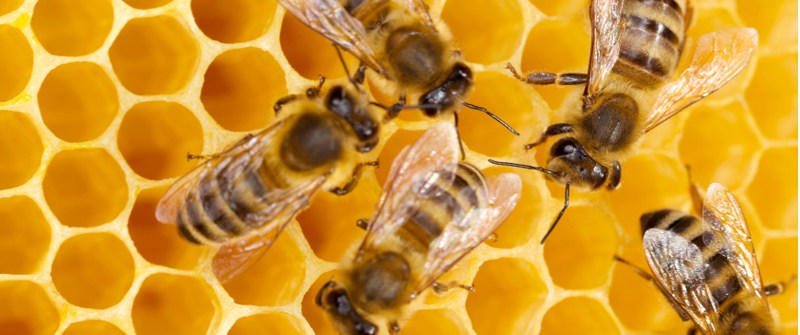
Khadi And Village Industries Commission (KVIC) is performing a major role in the growth and acceleration of the sweet revolution. Under the guidance and monitoring of the Indian government, KVIC launched India’s first “Mobile Honey Processing Van”. The chairman of KVIC, Vinai Kumar Saxena, launched this van at village Sirora in Ghaziabad. The Mobile Van has been planned in-house by KVIC at its Multi-disciplinary Training Center, Panjokehra, at an expense of Rs 15 lakh. This versatile honey handling unit can process up to 300 KG of honey in 8 hours. The van is additionally furnished with a testing research facility that would in a flash analyze the nature of honey.
The Mobile Honey Processing Van is a major step towards the development and growth of the mission. By following the footsteps of the prime minister’s dream of “Sweet Kranti” (Sweet Revolution) through the production of honey, the KVIC has brought this amazing innovation to enable farmers to get a fair price of their honey and also in increasing efficiency. KVIC has made the innovative Mobile Honey Processing Van that will process beekeepers’ honey at their doorsteps and thus save them the hassle and the expense of carrying the honey to processing plants in distant cities for the final analysis of honey’s quality. While making beekeeping a profitable business the Mobile Honey Processing Van helps the farmer to maintain purity in the quality of their products. The van also helps the farmer to avoid the unnecessary aging of honey as the processing will be done at their doorsteps. It also avoids transportation and high processing costs.
Addressing a community on the occasion, KVIC Chairman Shri Saxena said, the Honey Mission aims at increasing the honey production in the country and adding to the income of farmers and beekeepers. He said this innovative Mobile Honey Processing Van will serve multiple objectives. Besides reducing the honey extraction and processing cost to the beekeepers, it will also eliminate any scope for adulteration of honey as the processing will be done at the doorsteps of the beekeepers and farmers. This honey processing unit will prove to be a boon for small beekeepers and farmers who are incurring extra costs for bringing their honey to other cities for processing and packaging. He added that based on the experience of the pilot project, more such mobile honey processing units, particularly in the North Easters states, will be rolled out.
To keep away from high transportation and handling cost, a greater part of beekeepers would offer their crude honey to the specialists at their farms themselves at an exceptionally low cost. Accordingly, these beekeepers couldn’t bring the real financial advantages of beekeeping. This Mobile Honey Processing Van is probably going to help the beekeepers in country areas of states like Uttar Pradesh, Uttarakhand, Haryana, Delhi, Punjab, and Rajasthan.
- In 2017 with the approval of Prime Minister Khadi and Village Industries Commission (KVIC) had launched the Honey Mission In August for the Sweet Revolution. It’s been said that Honey Mission is being executed in two different phases.
- Phase I covers all the basic elements which are highly recommended and needed for the growth and completion of the mission. Awareness Training, Procurement & Supply of Bee boxes along with colonies and establishment of Apiaries.
- Phase II comes up with covering producing Marketing Network across the country. It may be launched on the Central level.
Honey Mission has an aim to provide Beekeepers a practical training about the observation process of honeybee colonies, assistance with apiculture equipment, proper study about bee disease identification, honey extraction and purification of wax, etc. In 2018 KVIC made a world record of circulating a maximum number of honey bee confines a solitary day beating past the best of 841 in Israel around two years prior. Further KVIC has dispersed more than one lakh honey bee boxes among farmers and jobless young people in the nation over in under two years under its ‘Honey Mission’ drive.
It might be noticed that under Honey Mission, KVIC has up to this point distributed almost 1.60 lakh honey bee boxes the nation over and made north of 40,000 businesses. In the Western Uttar Pradesh district alone, which has a wealth of vegetation, KVIC has conveyed almost 8000 honey bee boxes to farmers and beekeepers which has multiplied their income and expanded the harvest yield through cross-fertilization.
Action Plan Of Government Of India
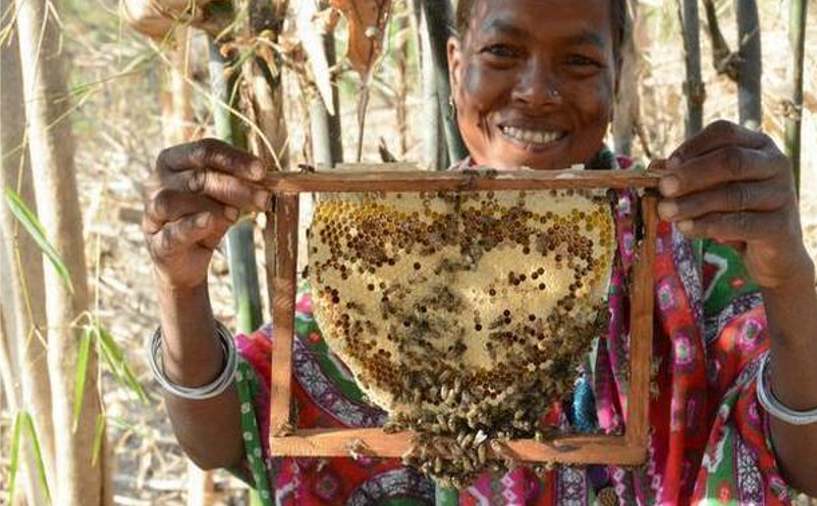
1. Plan Approval:-
Rs. 100 crore administrative approval for the year 2018-19. Under this scheme, more than 12000 farmers will be benefitted.
Rs 10 crore has been allocated.
Under the scheme, 1207 beneficiaries will be benefitted in the first phase.
District-wise targets have already been prepared.
2. Selection Of Farmers:-
- The farmers will be selected through the Chief Minister’s small and micro industries Board.
3. Training Of Farmers:-
- Farmers will be trained for beekeeping and production through our training centers.
- Apart from this Birsa Agricultural University, Krishi Vigyan Kendra will be trained through other Notified Agencies.
4. Unit Distribution:-
Each unit will be given a unit.
Each unit will have 20 bee colonies, 20 honey boxes, and one honey extract machine.
The government will give an 80% subsidy and the share of beneficiaries will be only 20%.
Each farmer will be given Rs. 80000 / – against a total unit cost of Rs. 100000 / – and farmers will have to contribute only Rs. 20000 / -.
6. Processing / Production / Marketing Support:-
The Jharkhand government will help farmers in the field of honey processing and marketing.
There are 7 processing units of different agencies in the state and they will help the farmers in the processing of raw honey
The state government will connect farmers with APEDA, the Government of India, especially for honey exports.
Top 13 Interesting Facts About Sweet Revolution
Khadi and Village industries commission sets a new world record of delivering a maximum number of bee boxes in a single day.
10000 beekeepers with 16 lakh honey bee colonies have been registered with NIB
Beekeeping has been useful in the pollination of crops also.
100 crore administrative approvals for the year 2018-19. Under this scheme, more than 12000 farmers will be benefitted.
Due to this initiative, India launched its first Mobile Honey Processing Van.
According to the United States Department of Agriculture, about 163,000,000 pounds (74,000,000 kg) of honey is produced in the United States each year.
An Average Honey Bee Farmer makes approximately $48,403 a year and $23 an hour in the United States.
In India, the total income of a beekeeper is around Rs. 1, 60,000.
In India, most of the bee farmers are in Punjab. Around 35,000 beekeepers deliver around 15,000 metric tonnes of honey.
39% of total honey production in India comes from Punjab.
The honey production in India has increased because of the Sweet Revolution. In 2013-14 it was 76,150 MTs and in 2019-20 it was 1, 20,000 MTs.
Exports of honey have also increased in India by 109.80% which is really commendable.
According to statistical research, India has secured 8th place in the world for Honey production. China stands first with producing volume of approx 444 thousand metric tonnes of honey in 2019.



